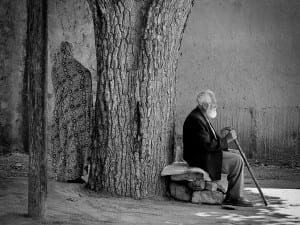In today’s age, we are all consumers. Whether digitally or authentically, humans are becoming part of a wider tapestry of experience that’s constantly called into question. It’s unsurprising, then, that immersive exhibitions and “Instagrammable”artworks are rising in popularity, as they force us to question our presence within “real” and “imagined” spaces. Perhaps this is the reason why Yayoi Kusama (b. 1929) is one of the most unprecedented artists of the 20th and 21st century. Another might be Kusama’s use of digital language that inspires mass appeal. Her manual creative process of continuous production and reproduction of images replicates the quality of digital processes. Walking into Victoria Miro’s, London, vibrant yellow, red and green ‘”forest” this autumn is an instant immersion into colour, pattern, form and light, trackable through the tag #InstaKusama. Viewers are surrounded by a virtuosic and playful experimentation with pumpkins.
Shifting from vivid objects to paintings, the exhibition is both illusory and seductive – moving between dimensions and creating a sense of acceleration. At times, the pumpkin is portrayed as having a character or personality– taking precedence within the gallery as an almost anthropomorphic presence. In other moments, it is deconstructed flat across paired canvasses: Dots Obsession[RDLAT] 2018 and Dots Obsession [CAMMC] 2018. Building both abstraction and pop-representation, the sensuality and hazard-like contrast of yellows and blacks are agents of allure – drawing the eye and holding our gaze. The paintings also reveal the basic building blocks of Kusama’s pumpkin imagery i.e. fragile digital-like grids of minuscule circles.
The focus on microcosmic elements of nature – both in the pumpkins and later in the gallery’s waterside garden with flamboyant flower sculptures – encapsulates other prominent elements in Kusama’s artistic practice; a unique dynamic between colour, polka-dot patterns and form. These gigantic outdoor sculptures with their intense colours and dot patterns face, as if interacting with, the pumpkins inside the gallery.
Kusama’s focus broadens in the My Eternal Soul Paintings room where her primordial-like works communicate and raise some of today’s most important issues including the love for humanity, representation of women, conflict and peace (Let’s Stop The War, 2015) and our place within our galaxy.(A Corner of the Sky, 2016). These themes are conveyed through an impressive corpus of large-scale square canvasses presented as an enormous, rectangular patch-like tapestry dominated by vibrant palettes.
The exploration of nature and the wider universe reaches its crescendo in the Upper Gallery installation Infinity Mirrored Room – My Heart is Dancing into the Universe 2018. Here, viewers are able to examine the universe’s infinite qualities associated with Kusama’s practice in a cubic, mirrored blackened space dominated by large round black paper lanterns dotted with oval white shapes, lit by diverse LED lights, providing a short loop of multiplying spot patterns and rapidly changing colours.
Whereas previously in the exhibition, the notion of the universe is expressed on an extremely large scale, in this reflective and deeply spatial room, audiences are tasked with the intimacy and literal impact of their physical presence within the world – at the intersection between the personal and the global.
Yayoi Kusama: The Moving Moment when I went to the Universe, Victoria Miro Gallery, London, until 21 December. www.victoria-miro.com
Galit Mana
Credits:
1. Courtesy of Victoria Miro and Yayoi Kusama.





